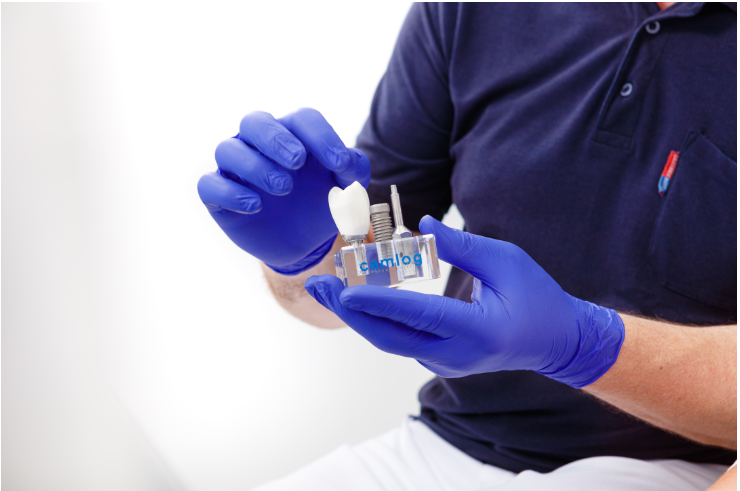Perfectly personalized denture – Flexible implementation process – With the latest tools
Surgeons: Dr. Óvári Zoltán; Dr. Gschwindt Sebastian; Dr. Kondrács Márk; Dr. Ruzsa Ádám
Our Oral Surgery
Our oral surgical techniques are designed to ensure that dental interventions are as gentle as possible. he majority of these procedures involve various tooth extraction methods. In most cases, surgical removal is necessary for wisdom teeth or root extractions, but even for simpler tooth extractions, surgical methods are employed to minimize damage to the surrounding bone.
The removal of minor mucosal lesions, bone reconstruction for implant placement, and specific treatments for the jaw joints are also performed through oral surgical procedures.
Local anesthesia ensures complete painlessness, but treatment under general anesthesia is also an option.

What are the advantages of oral surgical procedures?
It is not only necessary to resort to oral surgical methods when a tooth or root is in a position that cannot be removed using traditional methods. By employing appropriate surgical techniques, teeth can be extracted more gently, creating an optimal environment for future dental restorations. Healing is faster and involves less pain.
Important:before extracting a tooth, it is advisable to plan its replacement in advance.
Key benefits include:
- Faster and gentler removal of wisdom teeth with fewer complications during healing.
- After tooth extraction, there is less bone and gum resorption, making it easier to replace with either implants or traditional bridges.
- In cases of significant bone loss, it is possible to rebuild the necessary bone volume for implant placement.
What is the treatment process, what tools, and what techniques will be used?
In addition to local anesthesia, there is also the option of undergoing surgery under general anesthesia, especially recommended for the simultaneous removal of multiple wisdom teeth or larger bone grafts.
Wisdom Tooth Extraction
For gentle wisdom tooth extraction, we first take a CT scan in our practice. This allows us to determine the position of the tooth root and the location of the sensory nerve in the jawbone. It is crucial to avoid damaging the nerve during extraction. Deeply impacted or improperly positioned teeth are often worth dividing, reducing the amount of bone to be removed during surgery. By strictly adhering to regulations, we sometimes intentionally leave the root apex in the bone to avoid damaging the nerve running through the lower jawbone.
After wisdom tooth surgery, the wound is sutured, and if necessary, we prescribe antibiotics, painkillers, and medications to reduce post-operative swelling. A follow-up visit for suture removal is always necessary.
Simple Tooth Extraction
After every tooth extraction, the jawbone and the surrounding gum tissue undergo varying degrees of resorption and shrinkage. This can pose a problem when we want to replace the missing tooth later, as there may not be enough bone for implant placement, the future bridge may not be adequately cleanable, or it may cause aesthetic issues in visible areas. To avoid this, it is advisable to use surgical techniques even for simple tooth extractions. In such cases, after gentle tooth extraction, we fill the socket with bone graft material and often reposition a non-infected portion of the root as a “lid” to support the gum and promote better regeneration.
Pre-Implant Bone Augmentation
In cases of severe jawbone resorption, if we want to place an implant (artificial root), pre-implant bone augmentation may be necessary in the affected area. Nowadays, advanced and safe oral surgical methods are available for this purpose. We commonly use autogenous bone harvested from the surgical site or other intraoral areas, as well as bone graft particles from external sources—usually of animal origin but free from organic material. These materials are covered with a special tissue membrane to shape the growing bone and provide support. Depending on the size and shape of the missing bone, complete bone plates or smaller bone blocks are sometimes fixed—these are also obtained from other areas of the patient’s jawbone. These bone blocks can be gently harvested using ultrasonic instruments and fixed with small screws. Antibiotics, painkillers, and medications to reduce post-operative swelling are prescribed for these procedures. Post-operative wound control and suture removal are necessary.
Treatment under general anesthesia or sedation
The main advantage of dental procedures performed under general anesthesia or sedation is that patients can undergo treatment completely pain-free, eliminating concerns about fear or stress-related symptoms. The actual treatment is always preceded by a consultation with a specialist and an anesthesiology consultation. While no preliminary examinations are required for sedation, general anesthesia necessitates a comprehensive lab test, EKG, and chest X-ray. After the treatment, the patient can only leave the clinic accompanied by an escort.
Would you like to have your treatment done under general anesthesia or sedation? Book an appointment for a specialist consultation, during which you will receive detailed information about both sedation options!
Take care of your teeth!
Do you have a question? Write to us!
Articles on the topic
Our Patients Said
“For a while, I struggled a lot with my teeth, experiencing significant pain. However, a huge change happened after visiting CosmoDent. They solved my problems quickly, precisely, and painlessly! Professional team!”
Dóri
In the last two weeks, my wife and I visited you several times for check-ups, cleanings, and each of us had a filling done by Dr. Vivien Farkas or Márta Nagy. We would like to give feedback that we were very satisfied with the treatment. We are grateful for the helpful advice. The atmosphere at your clinic was very pleasant. It was great to experience how well you cared for us, without overdoing it. Although we don’t usually stress about going to the dentist, I noticed that the last time we went to you, we were completely relaxed, which I think is very cool considering that many people don’t like going to the dentist. We wish you continue to provide your service so beautifully!
Young Budapest Family
“I have been very satisfied with the services of Cosmodent for 16 years now. Extremely knowledgeable doctor team, modern technology, kind service, attention to detail.
I highly recommend the Team after numerous dental interventions.”
Réka
“The equipment and knowledge are unique at the clinic. I have been to many places, but I have never experienced such care! I came home with a bigger smile than I arrived with! Thank you!”
Ágnes
“It seemed like all my teeth had to be pulled out. However, after a thorough examination, it turned out that most of my teeth could be saved. The whole team, especially my dentist, Dr. Peter Rosta, made a great effort and did a fantastic job. I am already full of positive expectations for the next stage of my treatment, when I will get the implants. I really hope that after the complete treatment, I will have an aesthetic and, above all, functional set of teeth again.
I can only recommend the team at Cosmodent to everyone!”
Thomas
“I received the most thorough, attentive treatment at the dental clinic. I am completely satisfied. I will choose CosmoDent again for the next time!”
Erzsébet
“I really liked the new dental office. The new environment is very nice, the design of the dentistry gives the impression that one is in good hands. The employees there are very sympathetic, kind, and attentive. The hygiene is impeccable, which is a very important factor for dentistry even in this Covid situation. Overall, I recommend it to anyone who hesitates where to go.”
Aliz
“I have been to Cosmodent Dentistry for tartar removal treatment several times, performed by Éva Kriston. The treatment was thorough and painless, and Éva was kind and answered all my questions willingly. I will choose Cosmodent in the future as well.”
Kriszti
We apply various treatments thoughtfully, so we find the right one for everyone
- Through a thorough examination, we establish an accurate diagnosis.
- We consult with you to create a comprehensive treatment plan.
- Diagnostics, specialists, and dental technology all in one place.



